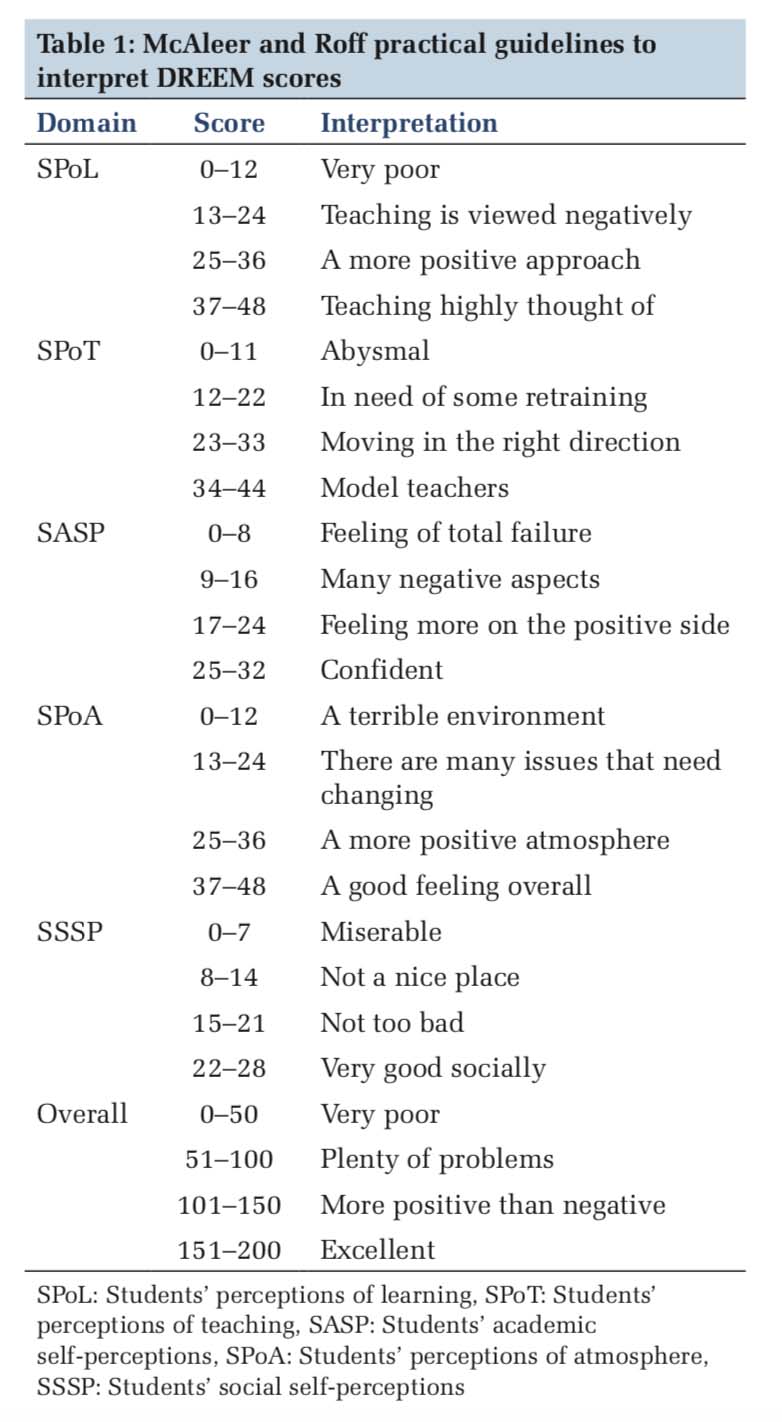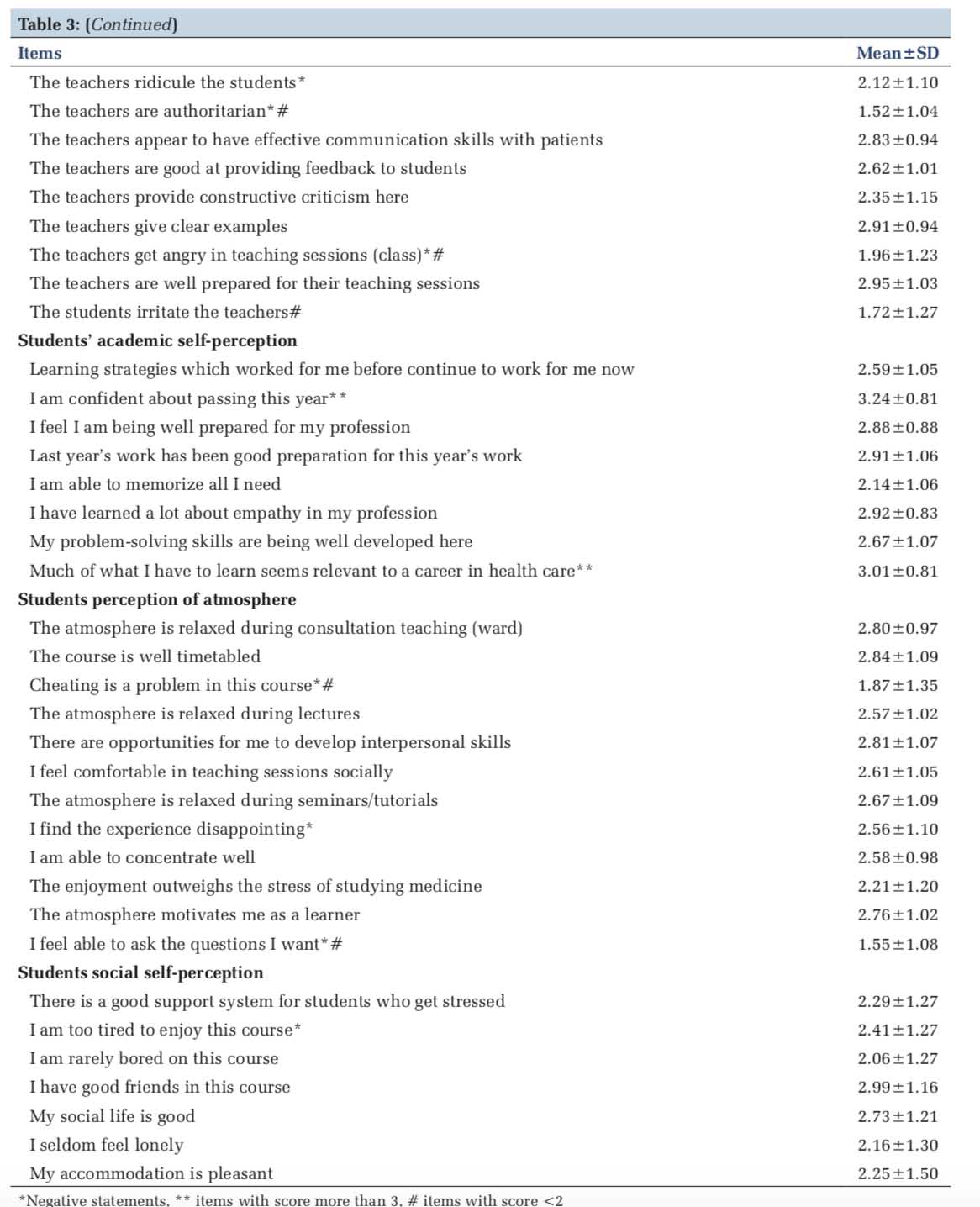

Journal of Medical Sciences and Health
DOI: 10.46347/jmsh.2018.v04i03.001
Year: 2018, Volume: 4, Issue: 3, Pages: 1-6
Original Article
N Asha Rani1, Aliya Nusrath1, M G Shivaramu2
1Department of Biochemistry, Adichunchanagiri Institute of Medical Sciences, B G Nagara, Adichunchanagiri University, Javaranahalli, Karnataka, India,
2Department of Forensic Medicine, Adichunchanagiri Institute of Medical Sciences, B G Nagara, Adichunchanagiri University, Javaranahalli, Karnataka, India
Address for correspondence:
Dr Asha Rani N, Associate Professor, Department of Biochemistry, Adichunchanagiri Institute of Medical Sciences, B G Nagara.
Background: The World Federation for Medical Education draws special emphasis on learning environment as one of the targets for the evaluation of medical education system. Students satisfaction on education environment strongly influences their approach to learning and the quality of learning outcome.
Objectives: The objectives of the study were to assess the student’s perception on educational environment using the Dundee Ready Education Environment Measure (DREEM) questionnaire among 2nd year undergraduate medical students.
Materials and Methods: A cross-sectional study was conducted among 2nd year undergraduate medical students. A globally accepted DREEM questionnaire was used as a tool to gather student’s perception toward the educational environment. DREEM questionnaire consists of five components with 50 statements assessed on five-point Likert scale (0–4). After obtaining ethical clearance, questionnaire was distributed among consented participants (n = 130). The completed questionnaires were collated for statistical analysis. Data were expressed as mean and SD, frequency, and percentages. McAleer and Roff practical guidelines were used to analyze and interpret the responses.
Results: The response rate was 86.15%. The overall mean DREEM score was 127.4 ± 29 (63.7%). Among the five domains of DREEM, academic self-perception was scored highest (69.9%) and social self-perception was scored least (60.4%). Statements “teachers are knowledgeable” and “I am confident about passing this year” scored ≥3 of 4 points.
Conclusion: The overall mean DREEM score was indicative of “a more positive than negative perception.” The more constructive responses were on student’s confidence, teacher’s knowledge, and curricular relevance, encouragement to participate in teaching session, teacher’s preparedness, and on having good friends in the campus. Nevertheless, there is a room for improvement in weaker areas such as student’s boredom and creative teaching.
KEY WORDS:Medical, student, learning, questionnaire, perception.
Medical education is transforming from “Sage on Stage” to “Guide by Side” where the role of medical teachers is to facilitate learning by providing proper content and a positive learning environment. The quality of the learning environment has been identified to be crucial for effective learning.[1] The World Federation for Medical Education draws special emphasis on learning environment as one of the targets for the evaluation of medical education system.[2] In India also, national accreditation agencies like the National Assessment and Accreditation Council emphasize on the educational environment as one of the important criteria in improving the quality system of an institution as evident by its mission statement “to stimulate the academic environment for promotion of quality of teaching-learning and research in higher education institutions.”[3]
Students satisfaction on educational environment strongly influence their approach to learning and the quality of their learning outcome.[4] Successful implementation and management of the curriculum can happen only with systematic feedback and assessment.[5] Understanding the student’s perception about educational environment plays a key role in designing and executing a holistic curriculum.
Globally medical educators are making an effort to reform the educational environment so as to make it learner friendly without compromising standards and quality of learning. Adichunchanagiri Institute of Medical Sciences, a rural medical college from South India, strives to provide outstanding educational experiences to the students through competent facilitators and supportive infrastructure. In this regard, this study was designed to assess the educational environment of Adichunchanagiri Institute of Medical Sciences as perceived by students using a globally accepted Dundee Ready Education Environment Measure (DREEM) questionnaire among undergraduate medical students.
A cross-sectional questionnaire-based study was conducted from September 2017 to February 2018 at Adichunchanagiri Institute of Medical Sciences among 2nd year medical undergraduate students to assess the perception of students toward the educational environment of the institute. A convenient sampling techniquewasusedandall150studentsof5th termwere invited to participate in the study as they are exposed to pre-clinical, paraclinical, and recently clinical teaching environment. The study was approved by the Institutional Ethical Committee. A prevalidated globally accepted DREEM questionnaire[6] was used as a survey tool to gather information on student’s perception toward educational environment offered by the institution. A pilot study was done and few terminologies were modified without changing the meaning of the items in the inventory.
The purpose of the study and maintenance of confidentiality was explained to the students. DREEM questionnaire was distributed among willing participants after taking written consent (n = 130). After half an hour, the completed questionnaire was collected back. The completed questionnaires were collated for further statistical analysis. Continuous variables were described as mean and SD, categorical variables were presented as frequency and percentage. McAleer and Roff practical guidelines[7] was used to analyze and interpret the responses.
DREEM questionnaire consists of five domains with 50 statements assessed on five-point Likert scale ranging from strongly agree (4) to strongly disagree (0). However, negative statements were scored in reverse order. These 50 items will be having a maximum score of 200 which indicates an ideal situation.
The five domains of DREEM inventory are as follows:
1. Student’s perceptions of learning (SPoL-12 items/48 marks)
2. Student’s perceptions of teachers (SPoT-11 items/44 marks)
3. Student’s academic self-perception (SASP-8 items/32 marks)
4. Students perception of atmosphere (SPoA - 12 items/48 marks)
5. Student’s social self-perceptions (SSSP-7 items/28 marks) [Table 1].
The individual DREEM items in each domain were interpreted as follows: Items having a mean score of ≥3.5 are real positive points; ≤2 indicates problematic areas and scores between 2 and 3 are aspects of the educational environment that could be enhanced.
Of the 150, 130 students consented to participate in the study and 112 students completed the questionnaire (response rate was 86.15%).
The global DREEM mean score was 127.4 ± 29.1(63.67%). The highest score was rated to student’s academic self-perception domain (69.9%)
and least for student’s social self-perception (60.4%) by the participants [Table 2].
Table 3 represents the individual item analysis in each domain of DREEM inventory. Highest was scored for the teacher’s knowledge and confidence of the students of passing the exams this year and least was scored for emphasis on factual learning and authoritative teachers.
The more constructive responses were on student’s confidence, teacher’s knowledge, curricular relevance, encouragement to participate in teaching session, teacher’s preparedness, and on having good friends in the campus.
Educational environment is one of the important determinants of an effective curriculum and also assist in the evaluation of program appraisal.[1] In this regard, the present study was conducted to examine the educational environment offered by our institution using DREEM inventory as a tool. The responses provided by the students identified the strengths and weakness in the learning atmosphere of the institute.
The overall mean DREEM score in the current study was 127.35±29.1, indicative of a “more positive than negative perception.” This is analogous with the overall results of several studies done in India[8-10] and other countries.[11-13]
According to McAleer and Roff guide,[7] the subscale DREEM scores of the present study indicate that the student’s perception of learning had a “more positive approach” and that their perception of teachers was “moving in the positive direction.” The academic self-perception of the participants was found to be “more positive atmosphere,” and the student’s social self-perception was “not too bad.”
The mean scores of all the five domains expressed as percentage were between 60.4% and 69.9%. This indicates that there is a scope for improvement and requires remedial measures to ensure and maintain a high-quality learning environment for the students.
The highest score was found in the subscale of student’s academic self-perception (69.9%) and lowest was for students social self-perception (60.4%). The results are fairly in agreement with others done in medical students and in students of other disciplines.[14-16]
There were seven items which scored > 3 score. Among these two statements, “The teachers are knowledgeable” and “I am confident about passing this year” scored > 3.2. This conveys that student is contended with the learning environment provided by the institution. They perceived that the faculty is well equipped with extensive knowledge to guide them in all aspects of medical course and is well prepared for the classes. Students were very much confident about passing this year, which may be attributed to the fact that they were regularly exposed to formative assessments as well as deftly established academic mentoring program in the institution. These results are in accordance with the reports of a few studies done in India.[8,17]
On the other hand, the students felt that faculty is little authoritative, overemphasizes factual learning, and lack in providing constructive criticism. Similar results were reported by few other researchers.[8-9,16] In this regard, it is important to sensitize the faculty that respect for the student is critical to the learning process. Further, the ability to give timely and specific feedback is an important skill that sets students on the right path to learning. Immoderate unpleasant criticism, on the other hand, or lack of feedback of any kind, is contemplated to be discouraging and damaging to students’ self-confidence. The teaching style and learning experience in pre-clinical and paraclinical subjects are more of theoretical and fact oriented while in clinical period, it is more of real-time experience and practical oriented.
This is the first-ever evaluation of medical student’s perception of educational environment at this institution, and thus it provides a baseline report to track the effects of constructive learning environment/program transformation over a period of time in future. Overall, the students perceived the educational environment at our institution as a positive one. The DREEM questionnaire in its existing pattern may not be completely assessing all aspects of a medical education system and a version that is more suitable to our set up is desirable.
This is a cross-sectional study with its own innate limitation. Response to DREEM questionnaire was collected only from 2nd year medical students without the involvement of students from other phases. Students perception on educational environment collected in the present study depicts the summative aggregate of learning experiences from basic science subjects. There is an implied assumption that learning environment may be consistent over time and across different subjects. A comprehensive frame of reflection across diverse and intricate learning subjects including clinical subjects may be more appropriate to assess the learning environment.




Students assessed the educational environment at this institution as more positive than negative; however, improvements are required across all five domains. The more constructive responses were on student’s confidence, teacher’s knowledge, curricular relevance, encouragement to participate in the teaching session, teacher’s preparedness, and on having good friends in the campus however there is a room for improvement in weaker areas such as student’s boredom and creative teaching.
We thank all the student participants of this institution who contributed by returning filled questionnaires and mentors at St. Johns Medical College for their timely support and guidance in completing this project taken up as a part of Advanced Course in Medical Education 2017.
Subscribe now for latest articles and news.